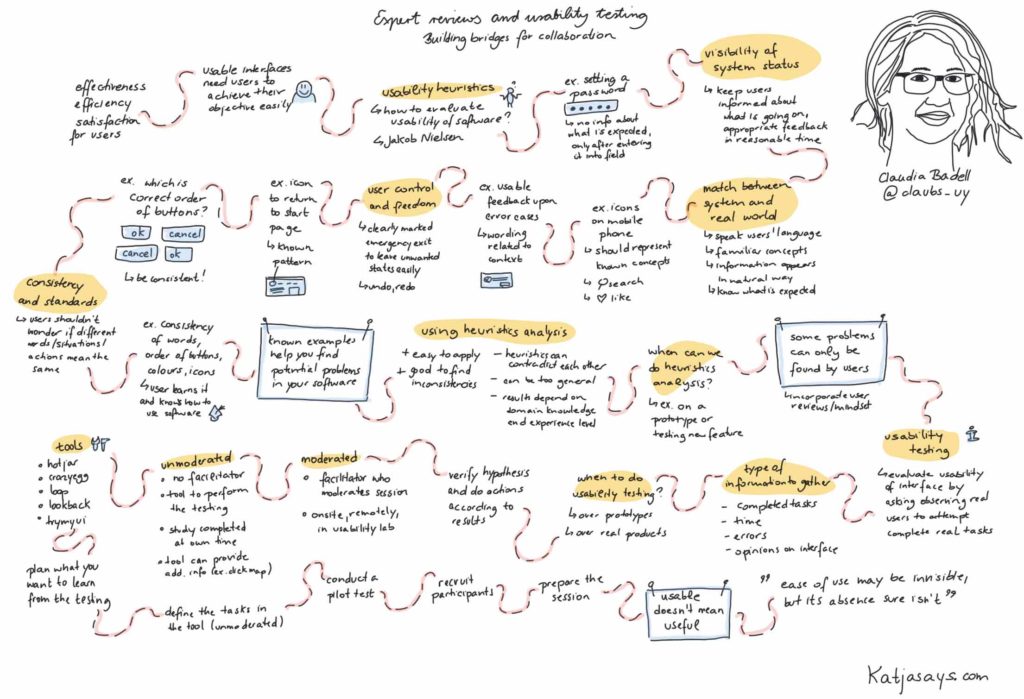The second day at the 2019 EuroSTAR Conference in Prague started at 09:00 with a keynote from Fiona Charles. She spoke about “Technology’s Feet on Society’s Ground“ and showed the audience lots of examples why we can’t always or shouldn’t trust AI totally. Algorithms still make mistakes and gather data, we don’t even know they are gathering. This leads to privacy violations and that more data is being collected than a person would like to be shared. Because we people are addicted to convenience, we tend to make choices that suit us well but which might be bad for the environment.
Fiona’s tips to fight this are:
- look for possible biases
- acknowledge technology’s limitations
- embrace human-centered computing
- build security in
- ground tech firmly in human society
- remember the small things that make up the fabric of society
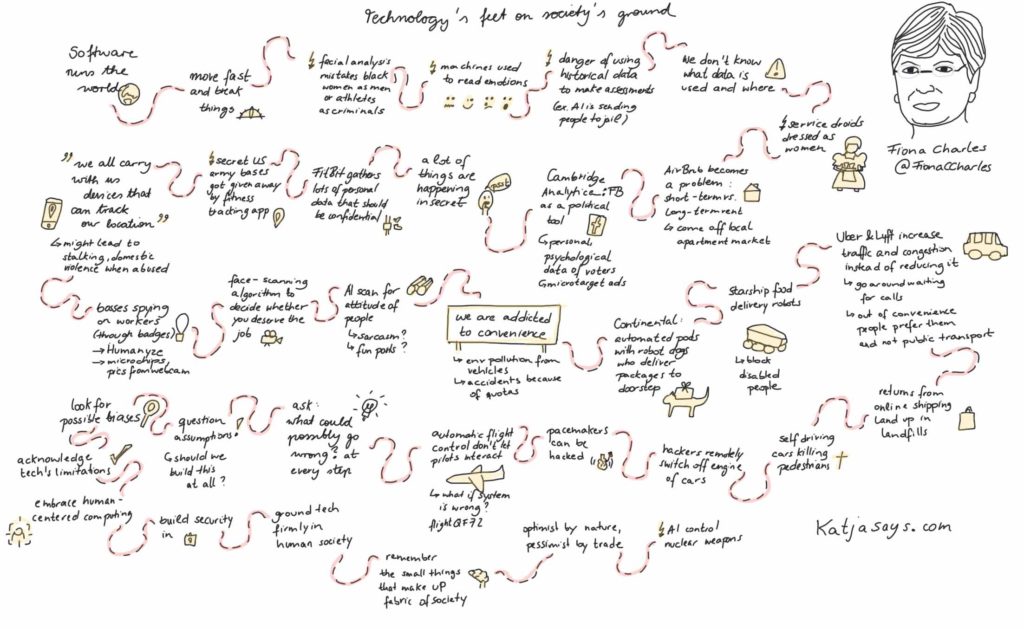
Following Fiona’s keynote I attended an amazing talk by Ingo Philipp with the title “Rediscover Exploratory Testing“. Ingo started by comparing exploratory testing with deodorant – the people who need it most don’t use it. He reminded us that tools do not test, but help us to test and that we shouldn’t automate chaos. He then compared software development to wrestling in the mud like a pig. The pig being the software and the mud being all the uncertainties around the IT. Software testing is then washing this dirty pig – there are no rules, no clear timelines and when you’re done, you can’t be sure it’s really clean. There is a knowledge gap between what we know and what we can know, and testing has the goal to close this gap. Something being tested means that it is being checked and explored. As exploration is central to testing, a human tester is needed. Some techniques are: session-based testing, requirements-based testing, tour-based testing, polychrome testing and scenario-based testing.
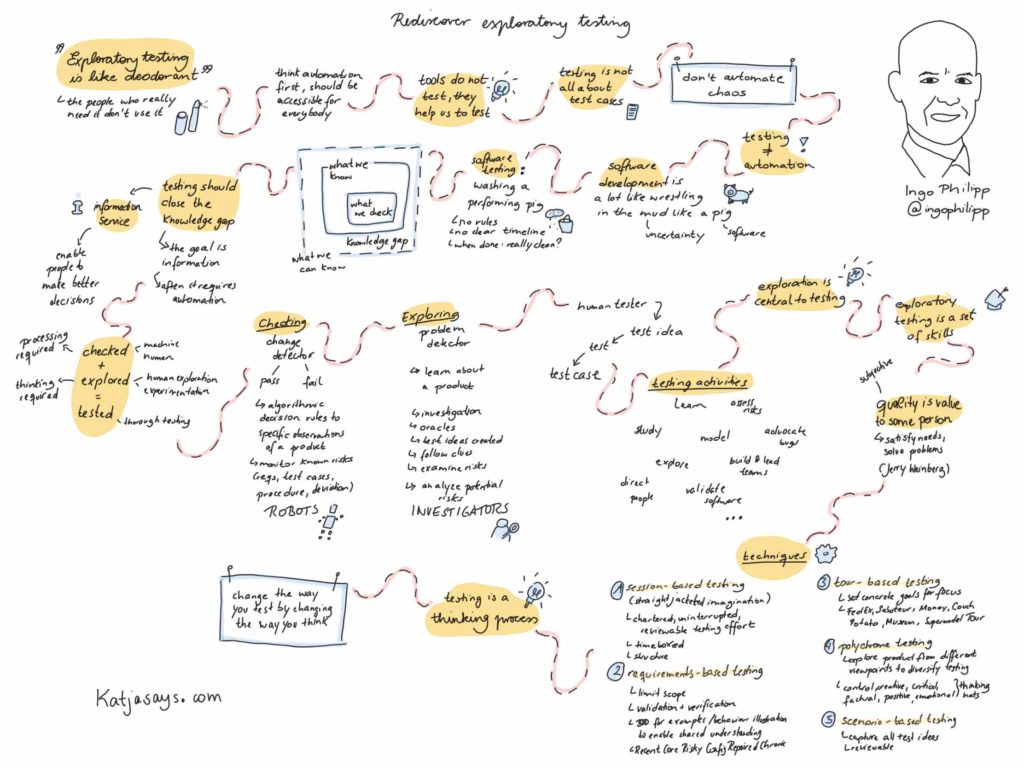
After a 30-minute coffee break during which we attendees had time to stroll through the busy Expo area, eat a snack and drink a cup of coffee, there was another slot of talks. I went to the talk “Expert Reviews and Usability Testing” by Claudia Badell. Claudia told us about usability heuristics by Jakob Nielsen, especially visibility of system status, match between system and real world, user control and freedom and consistency and standards. Known examples help you find potential problems in your software. You can use heuristic analysis when you have a prototype or when you are testing a new feature. Keep in mind that some problems can only be found by users. Therefore, usability testing is very important as well. Usability testing can be either moderated or unmoderated. If you want to start with usability testing, you should plan what you want to learn from the test, define the tasks (in the tool, if unmoderated), conduct a pilot test, recruit participants and prepare the session.
During the lunch break once again we had the opportunity to explore the expo area and the other areas like the EuroSTAR Huddle, Test Clinc or the Test Lab. Of course there was also some time for networking with other attendees.
After Lunch there was a new style of session called “Next Generation Keynotes“. This was a slot dedicated to three possible future keynote speakers who are already accomplished speakers and were given the opportunity to give their first talk on the Keynote stage. They applied during the EuroSTAR Call for Speakers and were mentored / coached by Fiona Charles since the programme launch in April so they would be well-prepared for their talk. Each talk was a max of 15 minutes.
The first speaker on stage was Adonis Celestine, with the talk “Why do lifts have Mirrors“. Customer experience is the x factor behind successful companies. Just as mirrors in lifts keep people occupied, by adding some small tweaks to our software we can keep users occupied while, for example, waiting for a page to load. Traditionally testers mostly concentrate on the functionality of a product whereas customers think that customer experience is most important – so a shift in the mindset is needed. The experience can be at the level “appeal to me” (customer on-boarding), “delight me” (customer retention) or “wow me” (customer loyalty). Adonis wanted us to keep in mind, that “wow” experiences often are personal and that customer experiences are made of moments, so we have to pay attention at all touchpoint.
The next speaker on stage was Shelley Lambert, talking about “The Art of Scaffolding“. Scaffolding means building a temporary structure that allows you to build the real thing. Along the way you should always ask “did I help someone with that” to determine whether you are going in the right direction or not. You need to fail and to succeed together and to help your team members learn and grow as you go.
The last speaker on stage was Ryan Volker, with a talk titled “Hey Testers, Justify your Existence“. Ryan told us that there are dark and lonely times for testers in which they have to justify their existence and prove their value. He showed us that it’s important to be an advisor, not a salesperson and to keep in mind the following things:
- dialogue, not monologue
- listen, actively
- think about what you are really doing
- solution before process
- grow your comfort zone
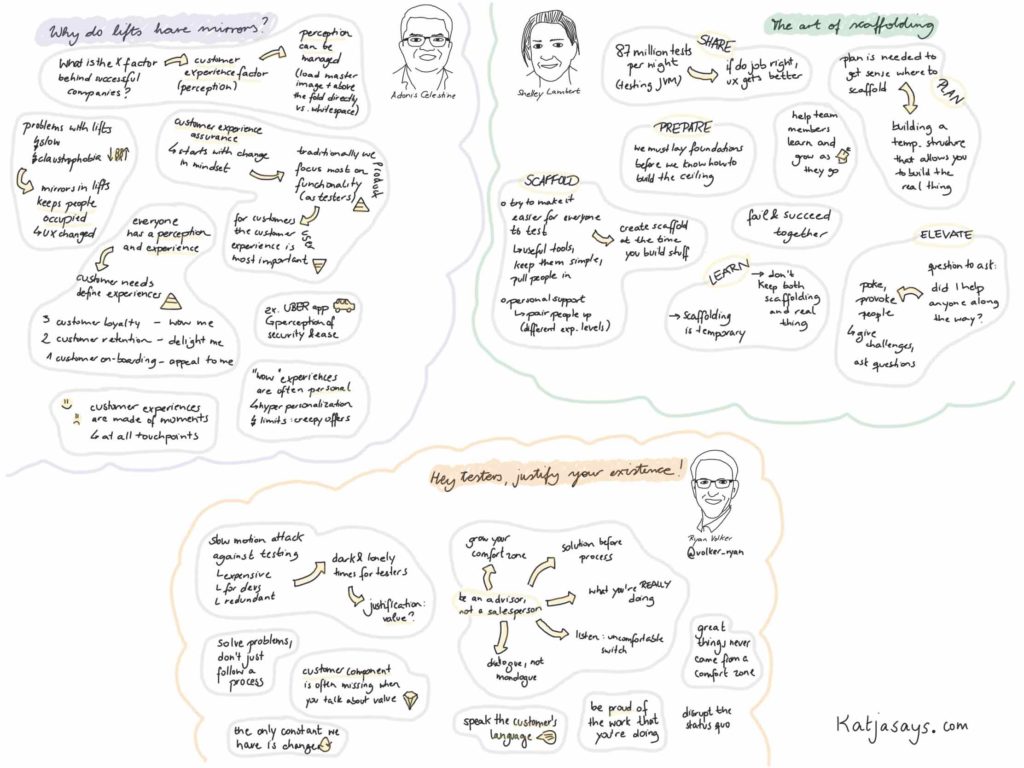
The next talk I was listening to was the one called “Leadership: from Monolith to Pebbles” by Adam Matlacz. Adam told us about his story from being the monolith who has the whole knowledge to building a shared understanding throughout his team. When given the chance to be the assistant test manager, he applied some copy pasting onto the estimations for process duration, resource requirements etc. from a previous test manager without thinking them through. As you might imagine this lead to crisis. To overcome the crisis and to not arrive at such a point again some day in the future, he learned, that there are three crucial parts to successful projects: the right culture, the right people and proper processes and structure.
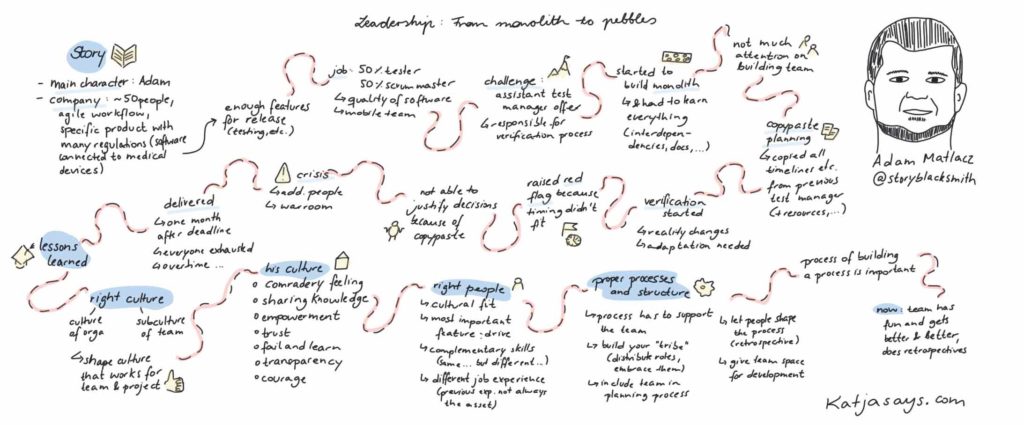
After some time to get another coffee, I listened to Jantien van der Meer and her talk “Good intentions Fly out of the Window“. Jantien was working in a team where everything went quite well: they were pairing, had coding standards, did Three Amigos meetings and so on. But then they were given a deadline for a project and this changed their way of working and decreased the quality of the software. Upon investigation, Jantien discovered, that stress was the source of this bad way of working. The team members had fallen into their primal instincts to flee, freeze, fight or focus and started to feel really unhappy. In such situations it is important to label/call your emotions by name. If you acknowledge your feelings, you can control them and steer yourself. If you stumble about such situations remember to ask for help, such reactions aren’t there by choice but because of primal instincts, so don’t blame the others and create awareness. For this it is necessary to create a safe environment and to build trust and confidence.
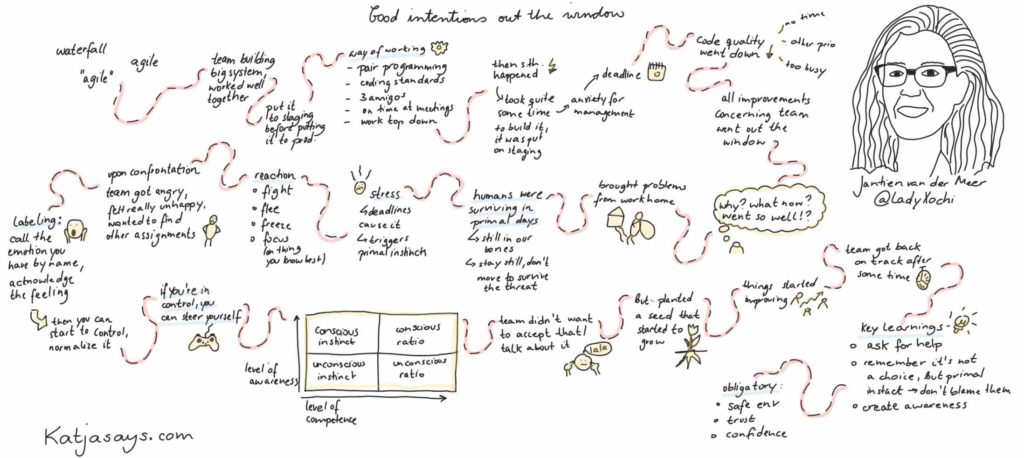
The time for the last keynote of the day has arrived: Alexandre Bauduin hold a keynote about “Flying High – Test Automation in the Boeing 777“. Alex started by explaining some things about flight simulators and that they basically have to simulate everything so that everything feels real, as if you are sitting in a real plane. With several million lines of code, 1-2 million parts and several kilometers of electric wires it is quite complicated to test an airplane. With a new simulator from the XR line it was possible to get new, Arduino-style hardware and a faster assembly. This led to the idea of automation. With strong version control you can test on desktop. This makes distributed testing possible. The assembly (hardware) could be tested, artifacts need to be generated and it had to be fast. Automated checks would mean more time to test in the simulator and an automated setup can help the engineers. The test requirements are given by the authorities. Alex decided to use the framework FitNesse for the automation. With the automation there were less subjective tests, the pilot know-how was part of the code and if the automation works, they could fly the plane. But keep in mind to challenge your automation and to challenge the established tests.
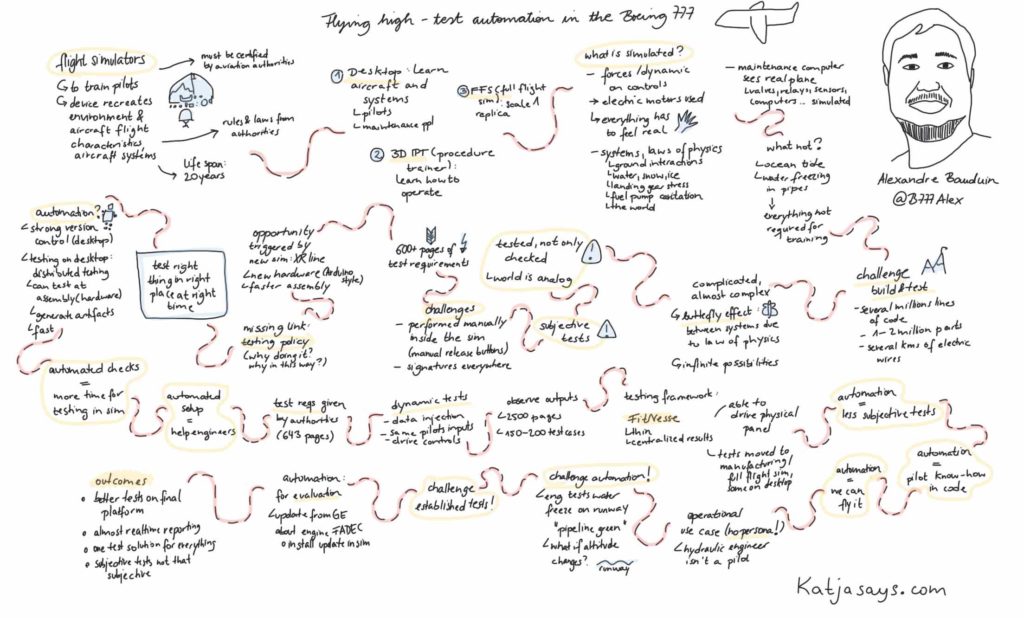
Although I attended a lot of talks and got a lot of input, the Wednesday of EuroSTAR 2019 was over very fast. I’m very much looking forward to the third day and hope to learn even more interesting things.

